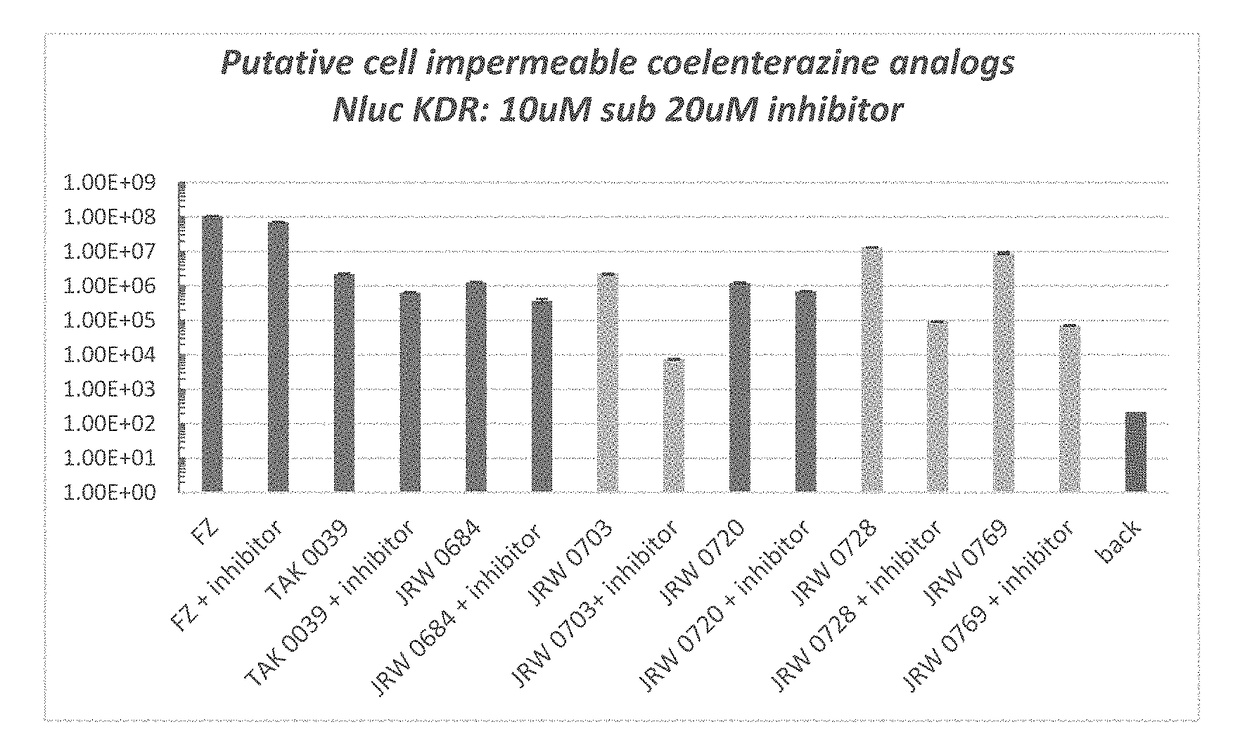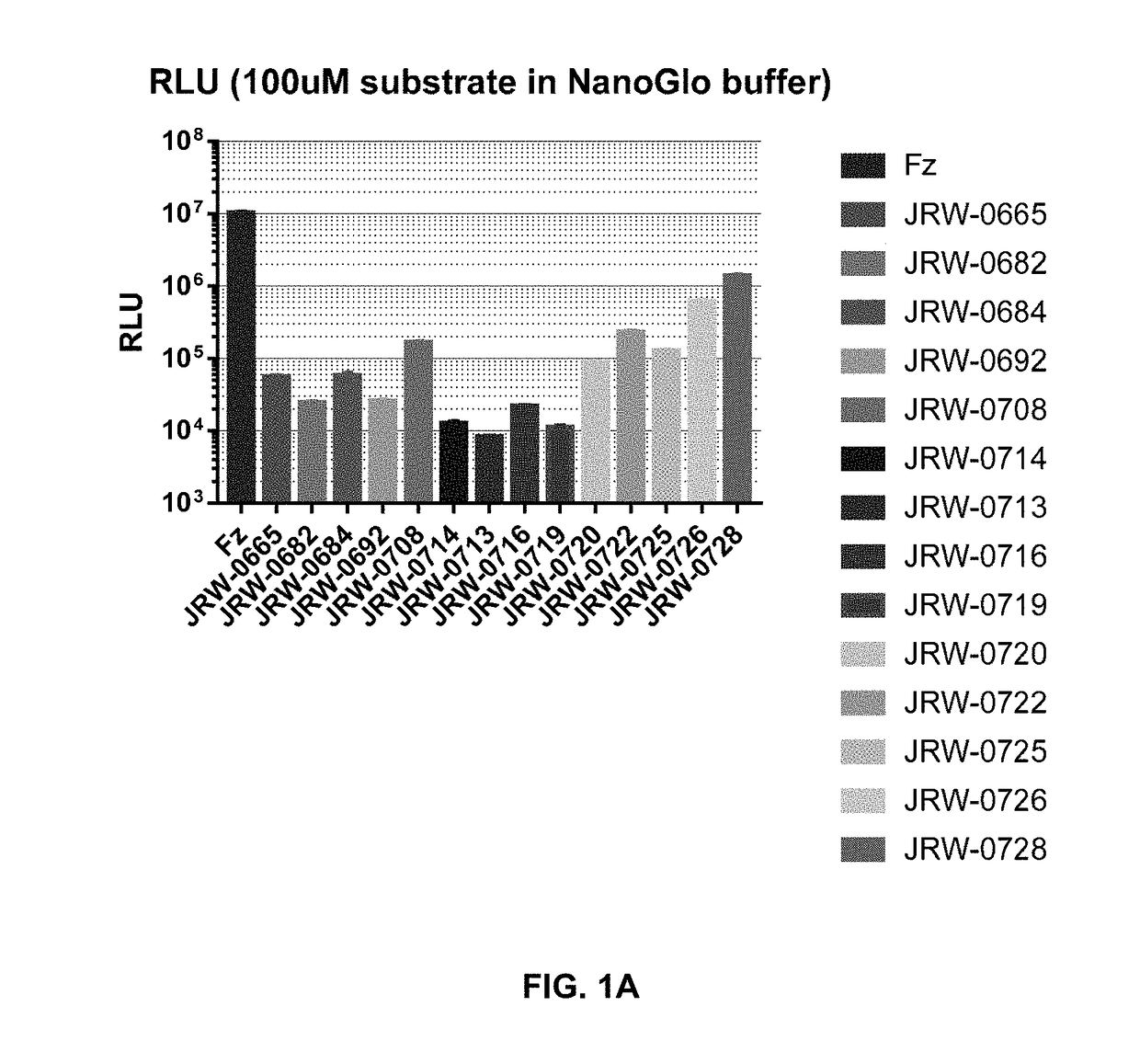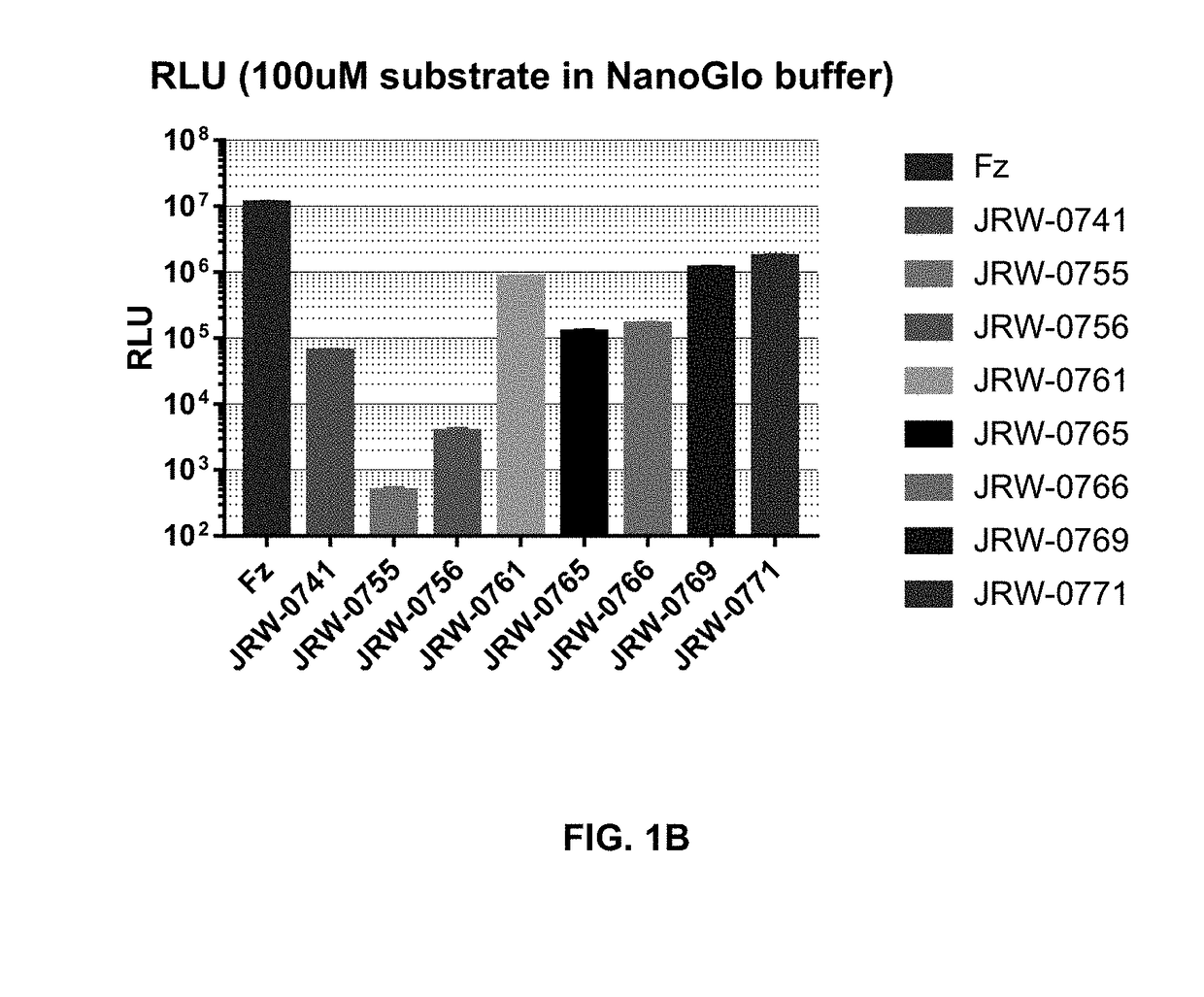Cell impermeable coelenterazine analogues
a coelenterazine and analogue technology, applied in the field of coelenterazine analogues, can solve the problems of inability to selectively observe cell surface or extracellular events, limited monitoring or imaging methods, and high equipment requirements, so as to reduce cell permeability, reduce cell permeability, and reduce the membrane permeability of coelenterazine analogs
- Summary
- Abstract
- Description
- Claims
- Application Information
AI Technical Summary
Benefits of technology
Problems solved by technology
Method used
Image
Examples
example 1
2,2,2-trichloroethyl 6-(4-((8-benzyl-3-oxo-6-phenyl-3,7-dihydroimidazo[1,2-a]pyrazin-2-yl)methyl)-2-chlorophenoxy)hexane-1-sulfonate (JRW-0665)
[0199]
Step 1. 4-((6-bromohexyl)oxy)benzaldehyde (JRW-0651)
[0200]
[0201]Following general procedure A, 4-hydroxybenzaldehyde (2.0 g, 16.4 mmol) was reacted with 1,6-dibromohexane (8.0 g, 32.8 mmol) to afford the desired product (3.1 g, 66%) as a white solid. 1H NMR (300 MHz, CDCl3) δ 10.87-10.46 (m, 1H), 8.87-8.48 (m, 2H), 7.85-7.78 (m, 2H), 5.01-4.67 (m, 2H), 4.41-4.07 (m, 2H), 2.83-2.52 (m, 4H), 2.45-2.25 (m, 4H); ESI MS m / z 285 [M+H]+.
Step 2. S-(6-(4-formylphenoxy)hexyl) ethanethioate (JRW-0653)
[0202]
[0203]To a solution of 4-((6-bromohexyl)oxy)benzaldehyde (3.00 g, 10.5 mmol) in DMF (30 mL), tetraethylammonium iodide (0.27 g, 1.1 mmol) was added. The mixture was cooled with an ice bath and potassium thioacetate (1.32 g, 11.6 mmol) was added. The mixture was warmed to RT, stirred for 1 h, diluted with ethyl acetate and water, and the aqueous ...
example 2
tert-butyl 6-(3-((8-benzyl-3-oxo-6-phenyl-3,7-dihydroimidazo[1,2-a]pyrazin-2-yl)methyl)phenoxy)hexanoate (JRW-0682)
[0210]
Step 1. ethyl 6-(3-formylphenoxy)hexanoate (JRW-0669)
[0211]
[0212]Following general procedure A, 3-hydroxybenzaldehyde (2.0 g, 16.4 mmol) was reacted with ethyl 6-bromohexanoate (7.3 g, 32.8 mmol) to afford the desired product (4.2 g, 97%) as a colorless oil. 1H NMR (300 MHz, CDCl3) δ 9.96 (s, 1H), 7.46-7.42 (m, 2H), 7.37-7.35 (m, 1H), 7.18-7.12 (m, 1H), 4.13 (q, J=7.1, 2H), 4.01 (t, J=6.4, 2H), 2.33 (t, J=7.4, 2H), 1.91-1.42 (m, 6H), 1.25 (t, J=7.1 Hz, 3H); ESI MS m / z 265 [M+H]+.
Step 2. 6-(3-formylphenoxy)hexanoic acid (JRW-0672)
[0213]
[0214]Following general procedure B, ethyl 6-(3-formylphenoxy)hexanoate (4.0 g, 15.1 mmol) was reacted with sodium hydroxide (19.7 mL, 1 M, 19.7 mmol) to afford the desired product (3.6 g, quant) as a white solid. ESI MS m / z 237 [M+H]+.
Step 3. tert-butyl 6-(3-formylphenoxy)hexanoate (JRW-0675)
[0215]
[0216]Following general procedure C...
example 3
6-(3-((8-benzyl-3-oxo-6-phenyl-3,7-dihydroimidazo[1,2-a]pyrazin-2-yl)methyl)phenoxy)hexanoic acid (JRW-0684)
[0221]
[0222]Following general procedure F, tert-butyl 6-(3-((8-benzyl-3-oxo-6-phenyl-3,7-dihydroimidazo[1,2-a]pyrazin-2-yl)methyl)phenoxy)hexanoate (80 mg, 0.14 mmol) was reacted with trifluoroacetic acid (1 mL) to afford the desired product (32 mg, 44%) as an orange solid. 1H NMR (300 MHz, CD2Cl2) δ 7.76-7.12 (m, 12H), 6.96-6.88 (m, 2H), 6.75-6.68 (m, 1H), 4.36 (s, 2H), 4.12 (s, 2H), 3.92 (t, J=6.4, 2H), 2.28 (t, J=7.3, 2H), 1.82-1.39 (m, 6H); ESI MS m / z 522 [M+H]+; HPLC 97.6% (AUC), TR 4.52 min; UV (MeOH)×431 nm, ε 8435.
PUM
| Property | Measurement | Unit |
|---|---|---|
| acquisition time | aaaaa | aaaaa |
| acquisition time | aaaaa | aaaaa |
| luminescence | aaaaa | aaaaa |
Abstract
Description
Claims
Application Information
 Login to View More
Login to View More - R&D
- Intellectual Property
- Life Sciences
- Materials
- Tech Scout
- Unparalleled Data Quality
- Higher Quality Content
- 60% Fewer Hallucinations
Browse by: Latest US Patents, China's latest patents, Technical Efficacy Thesaurus, Application Domain, Technology Topic, Popular Technical Reports.
© 2025 PatSnap. All rights reserved.Legal|Privacy policy|Modern Slavery Act Transparency Statement|Sitemap|About US| Contact US: help@patsnap.com



